In a groundbreaking achievement that redefines the possibilities of electric boating, the Candela C-8 Polestar Edition has obliterated the previous record for the distance sailed in 24 hours by an electric boat.
Crafted by Swedish electric boat manufacturer Candela, the C-8 electric hydrofoil boats are renowned for their exceptional efficiency, gliding gracefully over the water’s surface with just a fraction of the vessel in contact with the waves. This remarkable design translates into extraordinary energy efficiency, with the Candela C-8 utilizing a mere 20% of the energy compared to other electric boats, showcasing its prowess in the world of sustainable marine transportation.
The true essence of the Candela C-8’s superiority lies in its ability to cover impressive distances while conserving energy. Unlike electric boats with more substantial batteries, Candela’s collaboration with Polestar for the battery and charging system empowers the C-8 to tap into DC fast charging capabilities during short pit stops, thus maximizing its efficiency during journeys.
In a mission that transcended demonstrating the efficiency of a single battery charge, the Stockholm-based Candela team set out to underscore the paramount importance of DC fast charging within the realm of maritime applications. As articulated by the company, the goal was to ascertain how far they could venture in a day, making strategic use of DC charging to swiftly replenish the battery—a practice that owners are poised to embrace as DC charging networks expand across the US, Norway, and the picturesque French/Italian riviera.
The Candela team executed a relay of drivers throughout the day and night, harnessing the potential of a DC charger equipped with a Voltpack mobile battery system from Northvolt. In an awe-inspiring feat, they conquered an astonishing 420 nautical miles (equivalent to 483 miles or 778 km) within a 24-hour span. To put this remarkable accomplishment into perspective, it mirrors a round trip between London and Amsterdam or, for our American audience, a voyage from Tampa, Florida, to New Orleans or San Francisco to San Diego.
What adds a layer of astonishment to this achievement is not only the sheer distance but also the average speed maintained throughout the journey—an impressive 17 knots (equivalent to 19.5 mph or 31.5 km/h), including stops for charging. In contrast, Voltari’s boat, during its record-setting journey from Florida to the Bahamas, crawled along at just over trolling speeds, taking a grueling 18 hours to complete a voyage that conventional boats typically cover in two to three hours.
During its high-speed segments, the Candela C-8 effortlessly glided at nearly its maximum speed of approximately 27 knots (31 mph or 50 km/h). The route spanned between Stockholm and the island of Tynningö, punctuated by swift DC fast charging sessions after each circuit.
Candela’s remarkable achievement was a collaborative effort involving battery manufacturer Northvolt and charging station supplier Plug, serving as a vision of what future DC charging networks for boats might resemble. Instead of hefty investments in grid upgrades, islands and coastal regions could deploy battery systems like Northvolt’s Voltpack to ensure an ample power supply for rapid charging—a cost-effective and expeditious solution.
The Northvolt Voltpack, stationed on the dock outside Candela’s Frihamnen office, remained connected to a Plug DC charger, providing 17 successive recharges to the Candela C-8 during the 24-hour marathon.
Gustav Hasselskog, Candela’s CEO and founder, encapsulated the significance of this feat by stating, “This feat shows that fast, electric waterborne transport over long distances is viable today, not a distant future.”
Furthermore, the financial advantage of this achievement was palpable, with the total electricity cost amounting to approximately €110 (US $117), while a conventional boat would have incurred a staggering €1,400 (US $1,490) in fuel expenses for an equivalent long-distance journey.
As electrified marine transport takes bold strides forward, the vision of creating extensive charging networks to electrify passenger transport across Europe’s coastal regions, as envisioned by Hasselskog, becomes an ever more tangible reality. With a relatively modest investment, the dawn of a fully electrified maritime transportation network could transform the Stockholm archipelago and, by extension, coastal regions across Europe, forging a path toward a more sustainable and efficient future for marine transport.

